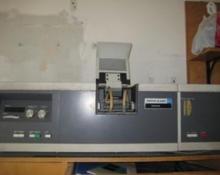The polarimeter is used to measure the optical rotation of optically active substances in solution. The instrument has two sources: a sodium and mercury lamp. The most common measurement wavelength is the sodium D line at 589 nm, but the mercury lamp can be used to provide measurement wavelengths at 578, 546, 436 or 365 nm.
The polarimeter was first used as a chemical instrument by Jean Baptiste Biot around 1816.1 By the mid nineteenth century they had achieved essentially modern form and they remained essentially unchanged through the 1980's.
This instrument uses a Nicol prism to produce a beam of plane-polarized light (generally the sodium D line is used as the monochromatic source), which then passes through a sample tube, after which it is analyzed using a second Nicol prism with a circular scale. In order to improve the readability and accuracy of the instrument aother Nicol prism, called a Lippich prism, is placed in front of the polarizer to create a split field by introducing a few degree rotation for half of the light. The instrument is now adjusted to match the two halves of the resulting field. The polarimeter can be used to determine concentrations of optically active substances as well as to aid in the identification of unknown compounds.

